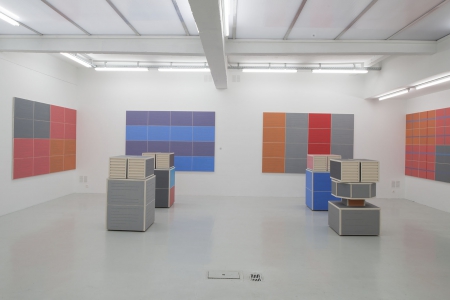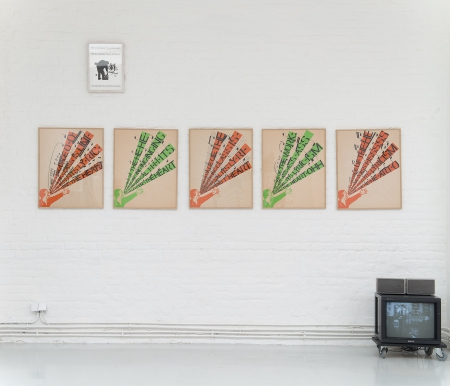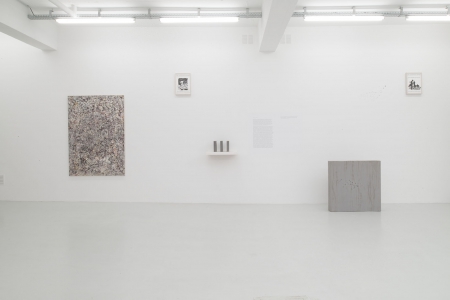Uncompleted
It is often said of the work of Art & Language that it is characterised by irony and parody. We think that this description is mistaken. While ‘irony’ and ‘parody’ may indeed come to the tip of the tongue in describing our work, we would say that it is more significantly characterised by its incompleteness. And it is in this incompleteness, or rather in its denial of its own completeness, that the work necessarily embodies its own displacement. It could be that the history of Art & Language is best conceived not simply as a collection of essays, but as the unfolding and indeed refolding of a kind of fiction. This is a virtual narrative of guises and disguises, voices, and indeed characters – the essayists themselves. We might say, for example, that the recent naturalisation of a text of ours – a work of pure fiction – as literal fact is an irony or a displacement or parody that has already been envisaged as a consequence of the work’s radical incompleteness. Similarly, ‘Portraits of V.I. Lenin in the Style of Jackson Pollock’ are uncompleted forms: while some viewers have confused them with actual paintings by Pollock, they leave the ethos of his work incomplete and unresolved in the form of portraits of which we can’t quite be certain.
Art & Language
This exhibition is part of
The Story of the Exhibition
We proposed to Art & Language, a group of conceptual artists active since the mid sixties, a solo exhibition of works from the collection. The chosen theme was: irony, parody, self-parody. We received a favourable response; Art & Language announced that a commentary would accompany this title. A few days later A&L sent a text to put on the walls of the exhibition. They suggested the title should be Uncompleted subsidized the theme of irony to that of incompleteness after the theorem of Gödel. According to Gödel a closed formal system such as mathematics cannot explain itself without referring to given axioms, undecidable statements that can be neither proved nor disproved. It therefore becomes impossible to develop a coherent theory which only allows for real things to be demonstrated. Following this correction we proposed to A&L for them to add a recent work that would illustrate this theorem of incompleteness. A&L sent Art & Language Paints a Picture, 2012, a set of poster projects for a past performance of The Jackson Pollock Bar. The JPB was originally a theatrical performance produced with professional actors who mimed a pre-recorded conversation broadcasted through loudspeakers. A later version to which our artwork refers to, took actors as directors of a particular performance, to realize a painting of A&L in the manner of Jackson Pollock, following the rhythm and indications given by an audio recording of the sounds in A&L’s studio.
Thus professional competence and the identity of the work’s authors, the usual criteria of assessment and judgment of a work of art, were challenged by this risky delegation. The same is true for the nature of the work: painting, theatrical performance or art of the idea?
This oscillation inside the work itself, which expands its limits while casting doubt on its own foundations, characterizes Index: Wrongs Healed in Official Hope, 1998 – 1999, presented in the exhibition. On the left side of the wall a pornographic text lies in place of the usual reproduction in typographical characters of a conceptual text. On the following panels this text passes through a reduction software in several stages, such that in the end, on the right panel it disappears. Only horizontal lines are left to feature the lost text. These lines play with the vertical edges of the various canvases that make up the entire panel. Those combined with the color variations of individual canvases are reminiscent of a Scottish tartan. So on one side the text culturally devalued: pornography, meticulous and detailed, objective descriptions similar to those of the Nouveau Roman, and on the other a decorative panel, art devalued, also of the order of the minor and kitsch. The transition from painting with text to abstract art in the same work dismantles the dogmas and assumptions of these two categories of painting. Such is also the case for the two portraits in the manner of Jackson Pollock included in the exhibition, criticisms of the opposition of figurative art abstract art, founding art styles of the twentieth century. This game on the limits of artistic categories and their definitions also characterizes other works in the exhibition such as Sunnybank Wall, 1965-67 or Singing Man, 1976 which can also be analyzed as such.
The Art of Wall Text
One of the themes developed in the collection is that of artists’ writings, and more specifically of long writings put up on walls. This excludes the use of puns, jokes, aphorisms or postmodern paradoxes, Fluxus but also the short-breathed conceptuals whose texts are limited to one, two or three sentences. But at the same time, pursuing such a path would create a new category of art of equal status as painting or sculpture. This, some artists wanted to avoid above all. Art & Language did insist on the unstable nature of the text, on a «sense of permanent instability and transition.» Isidore Isou, a lettrist artist had already declared in the early 60s to have quickly abandoned the idea of the artwork in Latin script on the grounds that creating such works would be too easy for a writer like him. Therefore an unstable field with indeterminate, elusive boundaries. To doubt the certainties of the wall text, a corollary of the doctrine of conceptual art, the so-called dematerialization, the text being supposed to replace the object, is one of the intents of this exhibition. A&L not only raises doubts about the nature of the wall text and the abilities of the artists who produce these texts, they also suggests it all is pure deception, and analyses it by means of the concept of Emergency Conditionals. ‘Emergency conditionals’ was written as a paper to the conference Philosophy and Conceptual Art, King’s College, London, 4th-5th June 2004: «This sense of permanent transition and instability brought us to what we called emergency conditional. The work was theory (or something) just in case it was art, it was art and just in case it was theory.” Pushing the spirit of parody further, A&L suggests in the work Index: Wrongs Healed in Official Hope, 1998-99, present in the exhibition, that the artist’s writing is not only the product of a shift in nature or misusage, it is also and above all the product of a deep misunderstanding. A&L takes the example of Mrs. Malaprop, «a character in Sheridan’s play ‘the Rivals’ first produced in 1775. She is noted for her aptitude in misapplying words. Among her more vivid locutions - or among Sheridan’s cleverest inventions - are ‘as headstrong as an allegory on the bank of the Nile’ or ‘He is the very pineapple of politeness.’ She was given her name to such solecisms.» (A&L Homes from Homes II jrp / ringier, Zurich, 2006, p. 250) And further on, p.258, A&L concludes with the question: «Could we say that the malaprop is in one sense paradigmatic of artist’s writings? It lives somewhere in the margin of the litteral. We might say that a malaprop ‘theory’ would be a theory ‘translated’ into malaprop.» Despite all those doubts about the artist’s writing being considered a work of visual art, A&L is a large producer of texts which have been published in museum catalogs they took over and in their own magazine Art & Language. What function does this magazine have? According to Charles Harrison and Fred Orton “Terry Atkinson’s introduction to the first issue suggests that he saw it as a kind of alternative to the art-gallery system- in delete circumstances where ‘essays’ were up for consideration as work of art – and thus as a means of launching an alternative career. David Bainbridge and Harrold Hurrell may have seen it as a way of securing control over the means of (certain forms of) ideological production. Michael Baldwin seems to have treated it as a means of discursive publication of ‘research’ which was free from the kinds of editorial control normally exercised in the name of rationality and readership.” (Charles Harrison and Fred Orton, A Provisional History of Art & Language, Editions E. Fabre, Paris, 1982, p. 16) As a proof of that plurality we refer the visitors to the following comments by the artists themselves.



